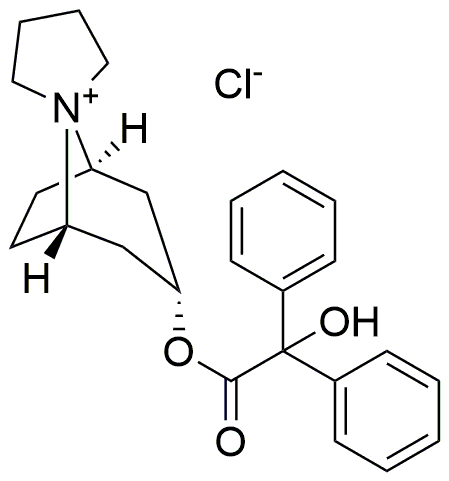Trospium chloride is widely utilized in research focused on
- Urology: This compound is primarily used to treat overactive bladder symptoms, providing relief for patients by reducing urinary urgency and frequency.
- Pharmaceutical Development: Trospium chloride serves as a model compound in drug formulation studies, helping researchers understand the pharmacokinetics and pharmacodynamics of anticholinergic medications.
- Clinical Trials: It is often a subject in clinical trials aimed at evaluating new therapies for bladder control issues, allowing researchers to compare efficacy and safety profiles against other treatments.
- Research on Anticholinergic Effects: This chemical is used in studies investigating the broader effects of anticholinergic agents on cognitive function, particularly in elderly populations.
- Combination Therapies: Trospium chloride is explored in combination with other medications to enhance therapeutic outcomes in managing urinary disorders, offering a more comprehensive approach to treatment.
Información general
Propiedades
Seguridad y normativas
Aplicaciones
Trospium chloride is widely utilized in research focused on
- Urology: This compound is primarily used to treat overactive bladder symptoms, providing relief for patients by reducing urinary urgency and frequency.
- Pharmaceutical Development: Trospium chloride serves as a model compound in drug formulation studies, helping researchers understand the pharmacokinetics and pharmacodynamics of anticholinergic medications.
- Clinical Trials: It is often a subject in clinical trials aimed at evaluating new therapies for bladder control issues, allowing researchers to compare efficacy and safety profiles against other treatments.
- Research on Anticholinergic Effects: This chemical is used in studies investigating the broader effects of anticholinergic agents on cognitive function, particularly in elderly populations.
- Combination Therapies: Trospium chloride is explored in combination with other medications to enhance therapeutic outcomes in managing urinary disorders, offering a more comprehensive approach to treatment.
Documentos
Hojas de datos de seguridad (HDS)
La SDS proporciona información de seguridad completa sobre la manipulación, el almacenamiento y la eliminación del producto.
Especificación del producto (PS)
La PS proporciona un desglose completo de las propiedades del producto, incluida la composición química, el estado físico, la pureza y los requisitos de almacenamiento. También detalla los rangos de calidad aceptables y las aplicaciones previstas del producto.
Certificados de análisis (COA)
Busque certificados de análisis (COA) ingresando el número de lote del producto. Los números de lote y de partida se pueden encontrar en la etiqueta de un producto después de las palabras "Lote" o "Lote".
Número de catálogo
Número de lote/lote
Certificados de origen (COO)
Este certificado de origen confirma el país en el que se fabricó el producto y también detalla los materiales y componentes utilizados en él y si se deriva de fuentes naturales, sintéticas u otras fuentes específicas. Este certificado puede ser necesario para cumplir con las normativas aduaneras, comerciales y regulatorias.
Número de catálogo
Número de lote/lote
Hojas de datos de seguridad (HDS)
La SDS proporciona información de seguridad completa sobre la manipulación, el almacenamiento y la eliminación del producto.
DownloadEspecificación del producto (PS)
La PS proporciona un desglose completo de las propiedades del producto, incluida la composición química, el estado físico, la pureza y los requisitos de almacenamiento. También detalla los rangos de calidad aceptables y las aplicaciones previstas del producto.
DownloadCertificados de análisis (COA)
Busque certificados de análisis (COA) ingresando el número de lote del producto. Los números de lote y de partida se pueden encontrar en la etiqueta de un producto después de las palabras "Lote" o "Lote".
Número de catálogo
Número de lote/lote
Certificados de origen (COO)
Este certificado de origen confirma el país en el que se fabricó el producto y también detalla los materiales y componentes utilizados en él y si se deriva de fuentes naturales, sintéticas u otras fuentes específicas. Este certificado puede ser necesario para cumplir con las normativas aduaneras, comerciales y regulatorias.


